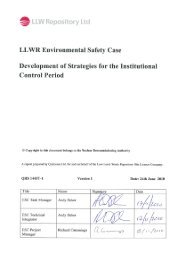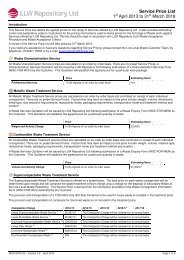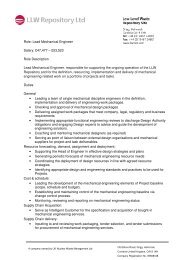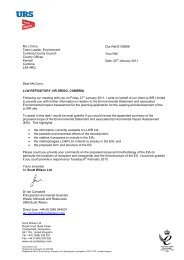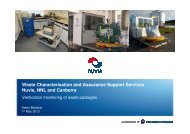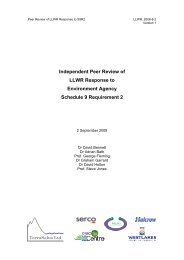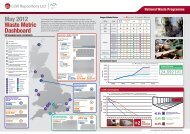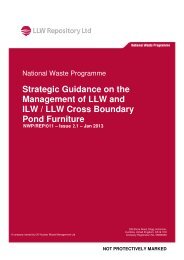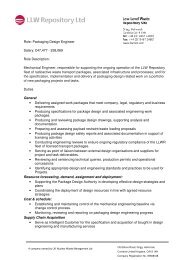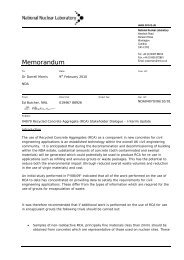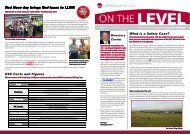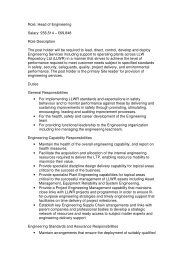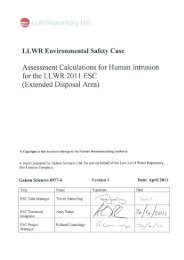Packing and Handling Instruction for the TC01(2910C) Type IP-2 ...
Packing and Handling Instruction for the TC01(2910C) Type IP-2 ...
Packing and Handling Instruction for the TC01(2910C) Type IP-2 ...
Create successful ePaper yourself
Turn your PDF publications into a flip-book with our unique Google optimized e-Paper software.
Package <strong>and</strong> H<strong>and</strong>ling <strong>Instruction</strong> <strong>for</strong> <strong>the</strong> <strong>TC01</strong> (<strong>2910C</strong>) <strong>Type</strong> <strong>IP</strong>-2 ISO ContainerPage 12 of 285.4 Vent <strong>and</strong> Grout Ports5.4.1 The venting port (See Figure 1), which is located in <strong>the</strong> container end panel, is openwhen <strong>the</strong> container is supplied from new <strong>and</strong> it must be sealed prior to shipment.See Section 8.3.1. If it is a reused container (see section 1.3 <strong>for</strong> definition) <strong>the</strong>n <strong>the</strong>vent port must be opened on arrival at <strong>the</strong> receiver’s site <strong>and</strong> it must be sealed priorto shipment. See Section 8.3.1.5.4.2 The grout port (See Figure 1), which is located on <strong>the</strong> container lid is closed <strong>and</strong>sealed when <strong>the</strong> container is supplied. This port is only used once <strong>the</strong> containerarrives at <strong>the</strong> repository <strong>for</strong> grouting on final disposal. The grout port must remainsealed prior to shipment. See Section 8.2.3.5.5 CSC Plate5.5.1 The CSC plate must be checked to verify that: <strong>the</strong> Container is still within itslicensed period i.e. within 5 years of <strong>the</strong> date of manufacture, <strong>and</strong>; <strong>the</strong> Containercan be filled, consigned <strong>and</strong> transported to <strong>the</strong> receiving facility within <strong>the</strong> periodstated on <strong>the</strong> CSC plate. Alternatively, where a package is being operated as a reusablepackage <strong>and</strong> an ACEP decal <strong>and</strong> associated maintenance decal aredisplayed adjacent to <strong>the</strong> CSC plate, check <strong>the</strong> next examination due date <strong>and</strong>verify <strong>the</strong> Container can be filled, consigned <strong>and</strong> transported to <strong>the</strong> receiving facilitybe<strong>for</strong>e <strong>the</strong> next examination falls due.5.5.2 Re-inspection <strong>and</strong> re-CSC certification of <strong>the</strong> container is required if <strong>the</strong> validitystated on <strong>the</strong> CSC plate has expired or is likely to expire prior to receipt at <strong>the</strong>receiving facility; or, where <strong>the</strong> package is operating under an ACEP, <strong>the</strong> nextexamination due date has passed or will pass prior to receipt at <strong>the</strong> receivingfacility.Re-inspections/examinations shall include a confirmatory leakage testing to verifycontainment integrity of <strong>the</strong> package: see guidance document PAA/GN01 LLWRepository <strong>IP</strong>2 ISO Container CSC Technical Inspection <strong>and</strong> Seal Leakage TestGuidance Document. [5]5.6 DecalsAll decals must be legible <strong>and</strong> securely affixed to <strong>the</strong> container body.5.7 Paint FinishThe external paint finish must be checked <strong>for</strong> damage/corrosion. Minor scuffing of<strong>the</strong> paint finish is acceptable but <strong>the</strong>re shall be no exposed bare metal. Anyexposed bare metal should be reported to <strong>the</strong> Contract Authority.5.8 Lid Removals5.8.1 Examine <strong>the</strong> lid retaining studs <strong>for</strong> damage; ensure all welds are free from defect,<strong>and</strong> that <strong>the</strong> retaining nuts can be freely rotated by h<strong>and</strong>. For any damaged orsheared studs refer to guidance document ref [7].5.8.2 Unscrew <strong>the</strong> nut/stud combination, once <strong>the</strong> nut becomes free (by h<strong>and</strong>) <strong>the</strong> lidclamp can be rotated through 90 <strong>and</strong> rested on <strong>the</strong> top plate, <strong>the</strong>re is no need tofully remove <strong>the</strong> nut <strong>and</strong> clamp during <strong>the</strong> removal of <strong>the</strong> lid.5.8.3 After removing <strong>the</strong> lid it should be set down on a clear area where it will not obstructloading operations <strong>and</strong> it should be supported at regular intervals (1.2 m) across <strong>the</strong>width of <strong>the</strong> lid as shown in Figure 5OM_LLWRGR_MECH_00007_A



